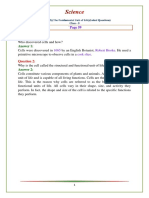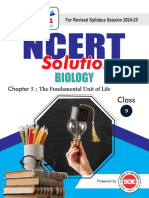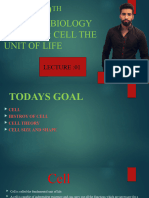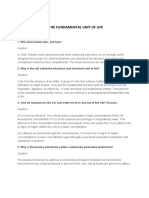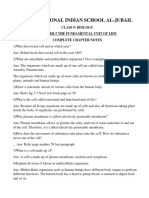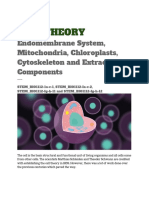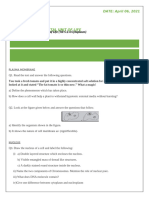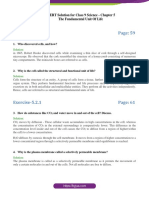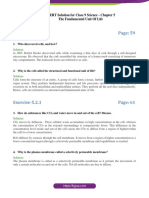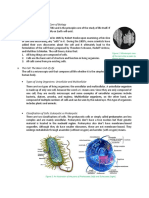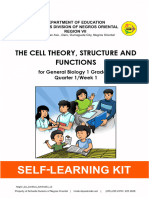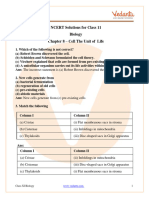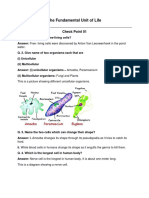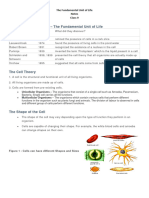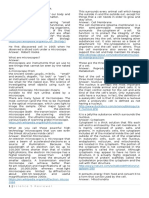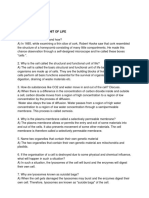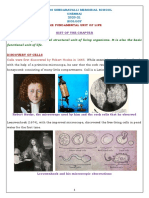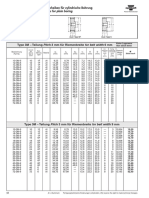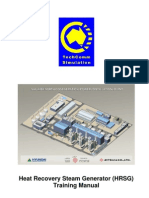9 Science Ncert Ch5
9 Science Ncert Ch5
Uploaded by
harish sharmaCopyright:
Available Formats
9 Science Ncert Ch5
9 Science Ncert Ch5
Uploaded by
harish sharmaOriginal Description:
Copyright
Available Formats
Share this document
Did you find this document useful?
Is this content inappropriate?
Copyright:
Available Formats
9 Science Ncert Ch5
9 Science Ncert Ch5
Uploaded by
harish sharmaCopyright:
Available Formats
CBSE
class IX Science
NCERT Solutions
Chapter - 5
The Fundamental Unit of Life
(Page No. 59)
1. Who discovered cells, and how?
Ans. In 1665, an English scientist named Robert Hooke discovered cells. He examined a thin
slice of cork under a self-designed microscope and observed that the cork resembled the
structure of a honey comb. Hooke named these tiny compartments as 'cells'.
2. Why is the cell called the structural and functional unit of life?
Ans. All living organisms are made up of cells so cell is the basic building unit of a living
organism and all the activities performed by a living organism are sum total of activities
performed by its cells hence cell is called the structural and functional unit of life.
(Page No.61)
1. How do substances like CO2 and water move in and out of the cell? Discuss.
Ans. The exchange of gases (CO2 and O2) between cells takes place by diffusion process.
Diffusion is defined as movement of a substance from a region of higher concentration to
lower concentration. CO2 is formed inside cell due to respiration and it accumulates in the
cell so its concentration is high in the cell as compared to the surroundings. On the other
hand O2 is utilized inside cell during respiration and therefore its concentration decreases
inside the cell while remains comparatively high in the surroundings. As a result
CO2 diffuses out and O2 diffuses into the cell.
2. Why is the plasma membrane called a selectively permeable membrane?
Ans. Plasma membrane is a highly specific structure. It is made up of lipids and proteins
Material downloaded from myCBSEguide.com. 1 / 6
which selectively allows the entry of substances into cell and exit of some other substances
from the cell i.e. selectively permeable.
(Page No.63)
1. Fill in the gaps in the following table illustrating differences between prokaryotic
and eukaryotic cells.
Ans.
(Page No.65)
1. Can you name the two organelles we have studied that contain their own genetic
material?
Ans. Chloroplasts and Mitochondria.
Material downloaded from myCBSEguide.com. 2 / 6
2. If the organisation of a cell is destroyed due to some physical or chemical influence,
what will happen?
Ans. If the organisation of a cell is destroyed due to some physical or chemical influence then
such cell would not survive any more as all components of that cell are digested up by its
lysosomes.
3. Why are lysosomes known as suicide bags?
Ans. Lysosomes are cell organelles filled with hydrolytic(digestive) enzymes. When a cell is
damaged, its lysosomes may burst out and its enzymes digest up its own cell. Due to this, we
can say that lysosomes are suicide bags.
4. Where are proteins synthesised inside the cell?
Ans. Ribosomes are the sites for protein synthesis inside the cell.
(Chapter – end)
1. Make a comparison and write down ways in which plant cells are different from
animal cells.
Ans.
2. How is a prokaryotic cell different from a eukaryotic cell?
Material downloaded from myCBSEguide.com. 3 / 6
Ans.
3. What would happen if the plasma membrane ruptures or breaks down?
Ans. The rupture or break down of cell’s plasma membrane indicates that cell is damaged
and in such condition the lysosomes of the damaged cells may burst and the digestive
enzymes present inside those lysosomes would digest their own cell. This will result into
death of the cell.
4. What would happen to the life of a cell if there was no Golgi apparatus?
Ans. The functions of golgi apparatus includes storage, modification and packaging of
products in the vesicles. If there was no golgi apparatus for a cell then all sort of storage,
modification, packaging and dispatch of materials within and outside the cell would be
impossible.
5. Which organelle is known as the powerhouse of the cell? Why?
Ans. It is Mitochondria of the cell also known as the power house of the cell because it
synthesizes energy in the form of ATP molecules during respiration which is vital for various
life activities.
6. Where do the lipids and proteins constituting the cell membrane get synthesised?
Ans. The endoplasmic reticulum is of two types:
Material downloaded from myCBSEguide.com. 4 / 6
i) Smooth endoplasmic reticulum (SER): It is responsible for the synthesis of lipids
constituting cell membrane.
ii) Rough endoplasmic reticulum (RER) : It bears the ribosomes and is therefore responsible
for the synthesis of proteins constituting cell membrane.
7. How does an Amoeba obtain its food?
Ans. Amoeba feeds on microorganisms (like planktons) which float on water. It develops
false feet or pseudopodia to surround the food. It captures the food within a sac like
structure called the food vacuole inside which digestion of food takes place.
8. What is osmosis?
Ans. Osmosis is the movement of water(solvent) from a region of high water concentration
through a semipermeable membrane to a region of low concentration of water. It can take
place only in liquid medium and not in solid or gases. Example is absorption of water from
soil by plant roots.
9. Carry out the following osmosis experiment:
Take four peeled potato halves and scoops each one out to make potato cups. One of
Material downloaded from myCBSEguide.com. 5 / 6
these potato cups should be made from a boiled potato. Put each potato cup in a trough
containing water. Now,
(a) Keep cup A empty
(b) Put one teaspoon sugar in cup B
(c) Put one teaspoon salt in cup C
(d) Put one teaspoon sugar in the boiled potato cup D.
Keep these for two hours. Then observe the four potato cups and answer the following:
(i) Explain why water gathers in the hollowed portion of B and C.
(ii) Why is potato A necessary for this experiment?
(iii) Explain why water does not gather in the hollowed out portions of A and D.
Ans. i) When we put one teaspoon sugar in cup B and one teaspoon salt in cup C, the
hypertonic solution is formed inside so through osmosis, water from outside enters inside
and collects in the hollowed portion of cups B & C.
ii) Potato A is necessary to observe osmosis.
iii) In hollowed out portion of A & D there is no solution (liquid medium) present therefore
osmosis cannot take place and as a result water does not gather.
Material downloaded from myCBSEguide.com. 6 / 6
You might also like
- Class 9 Biology Foundation Bharati BhawanDocument175 pagesClass 9 Biology Foundation Bharati Bhawans92% (12)
- Ammonium ChlorideDocument21 pagesAmmonium ChlorideDharmendra B MistryNo ratings yet
- CH - 5 - The Fundamental Unit of Life - Text Book ExercisesDocument6 pagesCH - 5 - The Fundamental Unit of Life - Text Book ExercisesUnkown HumanNo ratings yet
- Fundamental Unit of LifeDocument7 pagesFundamental Unit of LifeAadarsh RameshNo ratings yet
- G9 -BIO-M3-FUNDAMENTAL UNIT OF LIFE NOTESDocument3 pagesG9 -BIO-M3-FUNDAMENTAL UNIT OF LIFE NOTESsaeedabegum480No ratings yet
- Important Questions For CBSE Class 9 Science Chapter 5Document5 pagesImportant Questions For CBSE Class 9 Science Chapter 5Mr CrownNo ratings yet
- pr7IfQFJTnaR deKnLv7lhrDocument7 pagespr7IfQFJTnaR deKnLv7lhrSamarthsinh VaghelaNo ratings yet
- PDF Document-71Document7 pagesPDF Document-71rashidhaider7No ratings yet
- Class 9 Science NCERT Solution Chapter 5 The Fundamental Unit of LifeDocument36 pagesClass 9 Science NCERT Solution Chapter 5 The Fundamental Unit of LifeArtham ResourcesNo ratings yet
- The Fundamental Unit Of Life ❄O(∩_∩)ODocument7 pagesThe Fundamental Unit Of Life ❄O(∩_∩)OmrsrinathNo ratings yet
- 9 Bio 1Document8 pages9 Bio 1Amisha SenapatiNo ratings yet
- Science QuestionDocument1 pageScience QuestionAnil DhariwalNo ratings yet
- bioDocument3 pagesbiobm7947816No ratings yet
- Ncert Solutions CH 5 9 Class 20 21 (Number 1)Document6 pagesNcert Solutions CH 5 9 Class 20 21 (Number 1)Rajesh KumarNo ratings yet
- Class 9THDocument54 pagesClass 9THzargarfaisal690No ratings yet
- Bio Tissues and Fundamental Unit of LifeDocument9 pagesBio Tissues and Fundamental Unit of LifeKING MIDASNo ratings yet
- 9th Q&A CHAPTER 5Document7 pages9th Q&A CHAPTER 5Kanishk The calligrapherNo ratings yet
- 1. Cell Extra questionsDocument6 pages1. Cell Extra questionsia0266850No ratings yet
- 9 Cell SolutionsDocument10 pages9 Cell SolutionsThirupatikoila KoilaNo ratings yet
- Intext Q & A - Fundamental Unit of LifeDocument5 pagesIntext Q & A - Fundamental Unit of Lifeadhvaiidhappleid2010No ratings yet
- General Biology 1 - Q1 - Week 1Document16 pagesGeneral Biology 1 - Q1 - Week 1Rb Atienza EsguerraNo ratings yet
- Ncert Solutions Class 9 Science Chapter 5 The Fundamental Unit of Life - 0Document10 pagesNcert Solutions Class 9 Science Chapter 5 The Fundamental Unit of Life - 0Nischay MahamanaNo ratings yet
- 482020104354AM-Class 9 Biology NotesDocument7 pages482020104354AM-Class 9 Biology Noteskmdmohideen2297No ratings yet
- Fundamentals of Biological SystemDocument131 pagesFundamentals of Biological Systempon_parivendanNo ratings yet
- NOTES biologyDocument26 pagesNOTES biologygaganoberoi639No ratings yet
- Ch5_till ER Part1Document9 pagesCh5_till ER Part1pkhatri170308No ratings yet
- 01 Cell TheoryDocument9 pages01 Cell TheoryRay NavarroNo ratings yet
- Ncert Solutions Class 9 Science Chapter 5Document6 pagesNcert Solutions Class 9 Science Chapter 5ppusapatiNo ratings yet
- Cell Notes Class 9thDocument5 pagesCell Notes Class 9thgisbhairupa746No ratings yet
- Question and answersDocument10 pagesQuestion and answersanushaNo ratings yet
- Class 9 CH 5 and 6 Science PDFDocument52 pagesClass 9 CH 5 and 6 Science PDFananyatanwar001No ratings yet
- Exercise-5.1: NCERT Solution For Class 9 Science - Chapter 5 The Fundamental Unit of LifeDocument6 pagesExercise-5.1: NCERT Solution For Class 9 Science - Chapter 5 The Fundamental Unit of Lifenitika chawlaNo ratings yet
- Ncert Sol For Cbse Class 9 Sci Chapter 5 The Fundamental Unit of LifeDocument6 pagesNcert Sol For Cbse Class 9 Sci Chapter 5 The Fundamental Unit of LifeShah RukhNo ratings yet
- question answers scienceDocument5 pagesquestion answers scienceashaswingNo ratings yet
- The Science of Cytology Cell Theory: The Principle Core of BiologyDocument6 pagesThe Science of Cytology Cell Theory: The Principle Core of Biologyhendrix obciana100% (1)
- 225387cfc26691b974dbbdc9f5f09c1dDocument4 pages225387cfc26691b974dbbdc9f5f09c1drockstarnakshatraNo ratings yet
- NegOr Q1 GenBio1 SLKWeek1 v2Document13 pagesNegOr Q1 GenBio1 SLKWeek1 v2Rosales Angelbert C.No ratings yet
- CellDocument33 pagesCelldhavaleravi1992No ratings yet
- Cell ProjectDocument15 pagesCell ProjectCandiceNo ratings yet
- Cell Part II Class 9thDocument13 pagesCell Part II Class 9thmoinmushtaq51No ratings yet
- Class9-The Fundamental Unit of Life Long Answer QuestionsDocument8 pagesClass9-The Fundamental Unit of Life Long Answer QuestionsAnisha ThomasNo ratings yet
- NCERT Solutions For Class 11 Biology Chapter 8 - Cell The Unit of Life - .Document10 pagesNCERT Solutions For Class 11 Biology Chapter 8 - Cell The Unit of Life - .susilmaji92100% (1)
- Cells NotesDocument5 pagesCells NotesArnav VermaNo ratings yet
- The Fundamental Unit of LifeDocument22 pagesThe Fundamental Unit of LifeVishal YadavNo ratings yet
- Sadava MSCDocument118 pagesSadava MSCNikkizGogasNo ratings yet
- The Fundamental Unit of LifeDocument19 pagesThe Fundamental Unit of LifeSinchani SilNo ratings yet
- The Fundamental Unit of Life - CW Copy Notes Class 9 PDFDocument5 pagesThe Fundamental Unit of Life - CW Copy Notes Class 9 PDFmanoharrish3No ratings yet
- 01-Unit of LifeDocument29 pages01-Unit of LifeSENGUPTA CHANDANNo ratings yet
- Science 5 Quiz Bee ReviewerDocument7 pagesScience 5 Quiz Bee ReviewerRommel Urbano Yabis50% (2)
- 9th Notes TrivikramDocument20 pages9th Notes TrivikramsbvonlineclassesNo ratings yet
- Biology Notes Class 9 The Fundamental Unit of LifeDocument4 pagesBiology Notes Class 9 The Fundamental Unit of LifeSai Uday Shankar BommakantiNo ratings yet
- GQ 8 L PJ 4 SAdgz IO5 WUGo 5Document9 pagesGQ 8 L PJ 4 SAdgz IO5 WUGo 5dhairyasuthar2749No ratings yet
- 9 Fundmentals of LifeDocument8 pages9 Fundmentals of LifehayzkidsNo ratings yet
- CellsDocument8 pagesCellsShourya SanyalNo ratings yet
- AS Biology - Module 1 Chapter 1: Structure and Function of The Cell Introduction To The CellDocument11 pagesAS Biology - Module 1 Chapter 1: Structure and Function of The Cell Introduction To The CellJosebeth CairoNo ratings yet
- Cell The Basic Unit of Life EditedDocument22 pagesCell The Basic Unit of Life EditedQuerubin SalesNo ratings yet
- 9 BiologyDocument54 pages9 BiologygirishtiwaskarNo ratings yet
- Chapter - 8 Cell The Unit of Life - WatermarkDocument20 pagesChapter - 8 Cell The Unit of Life - WatermarkAleena JaigadkarNo ratings yet
- Gist of The ChapterDocument17 pagesGist of The ChapterDhanya BalasundarrajNo ratings yet
- SelfStudys DocumentDocument6 pagesSelfStudys DocumentSnigdha GoelNo ratings yet
- Resource 20200516093352 X Eng. 16 May The Ball Poem First FlightDocument4 pagesResource 20200516093352 X Eng. 16 May The Ball Poem First Flightharish sharmaNo ratings yet
- That They Can Attempt Topic-Related Questions Effectively.: General InstructionsDocument4 pagesThat They Can Attempt Topic-Related Questions Effectively.: General Instructionsharish sharmaNo ratings yet
- They Can Attempt Topic-Related Questions Effectively.: General InstructionsDocument4 pagesThey Can Attempt Topic-Related Questions Effectively.: General Instructionsharish sharmaNo ratings yet
- General Instructions:: Better Comprehension and Contact The Teacher in Case of Any Doubt/queryDocument2 pagesGeneral Instructions:: Better Comprehension and Contact The Teacher in Case of Any Doubt/queryharish sharmaNo ratings yet
- HTD Pulleys For Plain Boring: Optibelt ZRS HTD - Zahnscheiben Für Zylindrische BohrungDocument14 pagesHTD Pulleys For Plain Boring: Optibelt ZRS HTD - Zahnscheiben Für Zylindrische BohrungAbdessamad AyadNo ratings yet
- D16 - Cost Analysis, Literature Data (Incl. Pilot Plant Trials Conducted by Partners)Document23 pagesD16 - Cost Analysis, Literature Data (Incl. Pilot Plant Trials Conducted by Partners)rasheed_tech2012No ratings yet
- Safety Data Sheet: Di Deionised WaterDocument4 pagesSafety Data Sheet: Di Deionised Watercgjp120391No ratings yet
- Assembly Procedure of The Truck Os Mcoal Mining Body Part2Document55 pagesAssembly Procedure of The Truck Os Mcoal Mining Body Part2agus wahyudiNo ratings yet
- Transition Metal Isocyanide ComplexesDocument9 pagesTransition Metal Isocyanide Complexesfaheem0% (1)
- Chapter 11 SolutionsDocument14 pagesChapter 11 SolutionsVinicius CostaNo ratings yet
- Properties and Operating Experience With Bagasse As A Boiler FuelDocument6 pagesProperties and Operating Experience With Bagasse As A Boiler FuelAmulya KumarNo ratings yet
- Lubrizol 5161 - SN Booster - TDSDocument2 pagesLubrizol 5161 - SN Booster - TDSPranit More Arabian Petroleum LimitedNo ratings yet
- Multiple Effect Evaporator DesignDocument3 pagesMultiple Effect Evaporator DesignAnand Agrawal0% (1)
- 03 Stoichiometry With AnswersDocument19 pages03 Stoichiometry With Answersapi-287405319100% (1)
- All India Test Series (AITS) For NEET-2022 (O Ine) : Session: 2021-22Document2 pagesAll India Test Series (AITS) For NEET-2022 (O Ine) : Session: 2021-22Abhishek VinayakNo ratings yet
- IMECE2018-86589: General Correlation For Heat Transfer During Two-Component Gas-Liquid Flow in Horizontal PipesDocument9 pagesIMECE2018-86589: General Correlation For Heat Transfer During Two-Component Gas-Liquid Flow in Horizontal Pipesmostafa shahrabiNo ratings yet
- Silabo - 17201Document7 pagesSilabo - 17201Enrique Rojas BermudoNo ratings yet
- CHEM 20273 F23 Problem-Solving Set 8Document4 pagesCHEM 20273 F23 Problem-Solving Set 8Nitin PNo ratings yet
- Shuaiba North HRSG ManualDocument91 pagesShuaiba North HRSG Manualmartinp17171100% (8)
- Analysis of Laterally Loaded Drilled Shafts and Piles Using LpileDocument51 pagesAnalysis of Laterally Loaded Drilled Shafts and Piles Using LpileSudharsananPRSNo ratings yet
- NPR 8 (4) 345-355Document11 pagesNPR 8 (4) 345-355Ricardo Telgie MoralesNo ratings yet
- Standards and Guidelines For Natural Gas Fuelled Ship Projects'Document133 pagesStandards and Guidelines For Natural Gas Fuelled Ship Projects'mohammad kassarNo ratings yet
- CompressorsDocument6 pagesCompressorsErmiyas MistreNo ratings yet
- All Assumptions All WorkingsDocument5 pagesAll Assumptions All WorkingsJonathan ByamunguNo ratings yet
- GGBS Usage in ConcreteDocument16 pagesGGBS Usage in Concretesuraj george kNo ratings yet
- BIOCHEMISTRY Course OutlineDocument3 pagesBIOCHEMISTRY Course OutlineLawrenz PendeltonNo ratings yet
- Aerospace Interview QuestionsDocument9 pagesAerospace Interview QuestionsrsugarmanNo ratings yet
- Agitation MixingDocument23 pagesAgitation MixingvicdejoNo ratings yet
- Dielectric and Optical Properties of Polymer-Liquid Crystal CompositeDocument5 pagesDielectric and Optical Properties of Polymer-Liquid Crystal CompositeAybüke ÇalıkoğluNo ratings yet
- Water Treatment Processes and Plant Design Home-Take Exam (50%)Document2 pagesWater Treatment Processes and Plant Design Home-Take Exam (50%)awol mohammed100% (1)
- Analysis of Test Results: 2.1 Borehole LocationsDocument28 pagesAnalysis of Test Results: 2.1 Borehole LocationsTarun BisenNo ratings yet
- G9 Revision NotesDocument74 pagesG9 Revision Noteskwokrenee827No ratings yet
- Functional GroupsDocument3 pagesFunctional GroupsManofMiracles89No ratings yet






